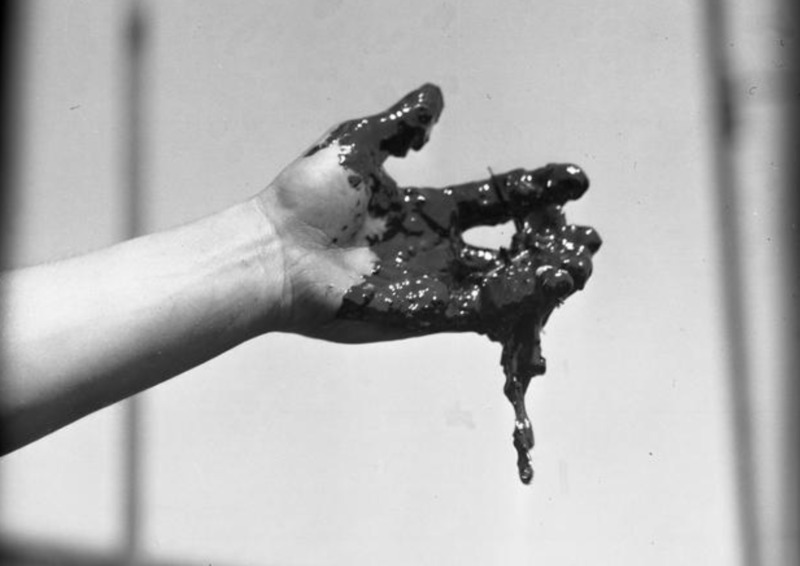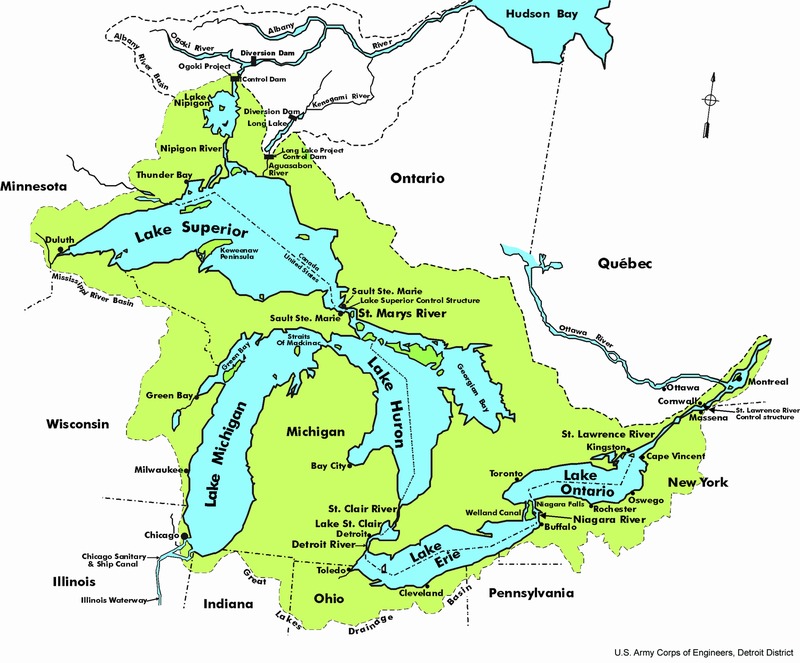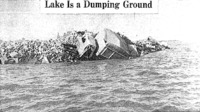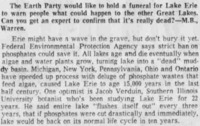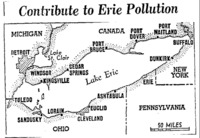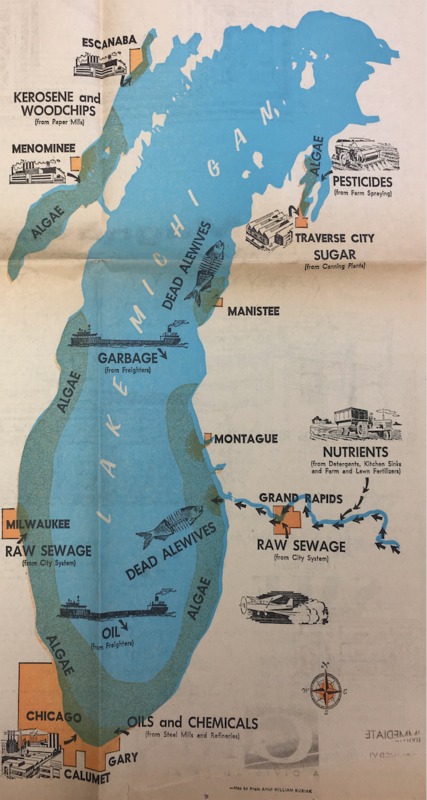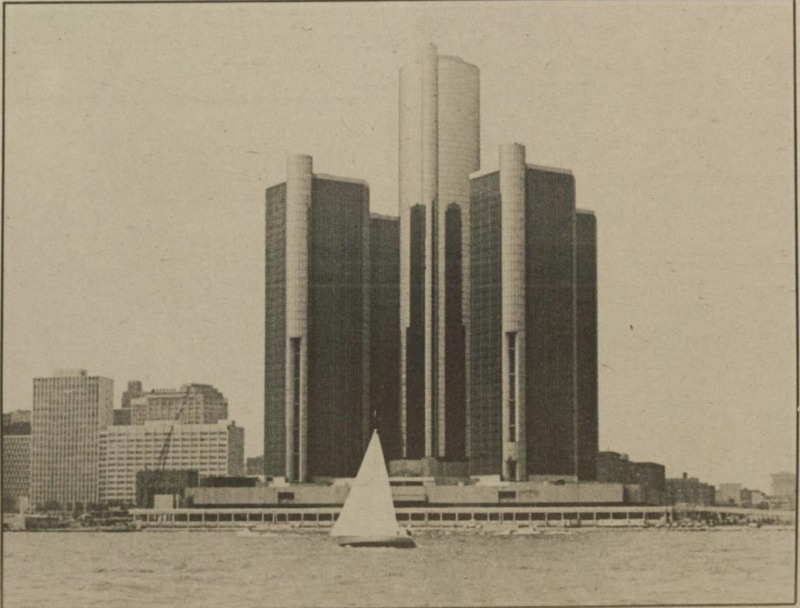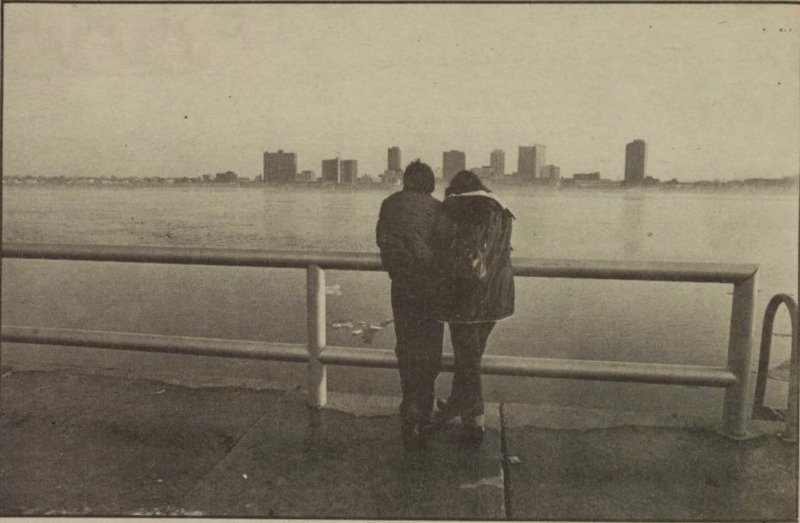Great Lakes Pollution
"Great Lakes: No Free Lunch," produced by the University of Michigan Television Center in 1981, examined the Great Lakes, and specifically Lake Erie, asking how this beautiful resource was undergoing slow but dangerous changes. The reason for these changes is the ongoing dumping of toxic chemicals from industrial plants. The host, Janice Reid, asks: is it too late to change the trend?
The Great Lakes — Lake Huron, Ontario, Michigan, Erie and Superior— span 750 miles from West to East, and are situated across 9 state/territory borders: Minnesota, Wisconson, Illinois, Indiana, Michigan, Ohio, Pennsylvania, New York and Ontario. This area is referred to is the Great Lakes Basin. Altogether, the 5 lakes comprise the largest fresh water source on Earth. There have historically been many uses for water in the Great Lakes Basin. The area has many spots for fishing, boating and other popular recreational activities, and serves as an important mode of transportation of goods. The lakes are crucial for wildlife and ecosystems, and also sustain an important potable drinking source for our country. However, the Great Lakes have not always been able to safely provide this diverse quantity of uses. Many governmental actions and commissions aided in the cleanup and maintenance of the lakes, and continue to contribute to their wellbeing today.
The greater area of the Great Lakes Basin was used as a waste disposal site and became heavily polluted throughout the late 1900s. Chemicals, toxic pollutants, pesticides and heavy metals entered the Great Lakes; they flowed from thousands of factory discharge pipes and sewage plants, seeped from dumping and disposal sites, escaped from smokestacks, and ran off millions of acres of cities and farmland from states surrounding the lakes. Not only did the chemicals gather and accumulate in the Basin, but they also spread and leaked into areas surrounding Great Lakes. Even in the smallest concentrations, the toxins that were distributed out via the Great Lakes are capable of causing cancer, birth defects and damage to the nervous and immune systems. Some can resist breakdown by biological processes, so they are able to persist in the ecological food chain for years; pollutants like phosphorus or PCB can accumulate in fatty tissue, and their concentrations increase exponentially as they move through the food web. Additionally, each toxin works in combination with many others, which complicates efforts to understand their effects.
"Lake Erie is Dead"
Of all of the Great Lakes, Lake Erie had become predominantly polluted by the 1960s, largely due to the heavy industrial presence along its shores. With 11.6 million people living in its basin, and with big cities and sprawling farmland dominating its watershed, Lake Erie is severely impacted by human activities. For decades, factories had been dumping chemical pollutants in to the lake and the waterways that flowed into it, like the Cuyahoga River in Cleveland, OH, and the Detroit River in Michigan. Since the Great Lakes Basin lacked substantial government oversight, waste and pesticides from surrounding cities' sewers, industrial plants and agriculture made its way into the lake. as did fertilizer and pesticides from agricultural runoff. Dead fish began to appear along the Lake's shoreline, leading to the coining of the phrase “Lake Erie is dead,” which started to appear in national publications in the late 1960s.
In recent decades, scientists, engineers, planners and technical experts formed the International Join Commission (IJC), an organization that unites Canada and the United States to fight to resolve disputes relating to the waters along their shared border. According to the IJC, "in the decades leading up to the 1970s, loadings of nutrients, particularly phosphorus from municipal sewage treatment plants and other anthropogenic sources, visibly degraded Lake Erie. This excessive nutrient enrichment, known as eutrophication, resulted in severe algal fouling of the lake, which in turn created aesthetic, taste and odor problems, reduced available oxygen and led to fish die-offs."
The University of Michigan's School of Natural Resources released a video series titled "Ecology Environment and Man," and this clip is from the episode titled "Water Pollution." The video discusses how many bodies of water end up in Lake Erie, including the Cuyahoga River, the Detroit River, and many other rivers and streams situated more North in Michigan. With its bordering territories of Michigan, Ohio, Pennsylvania, New York and Ontario, Lake Erie collects wastes and chemicals of all kinds from modern civilization, including industrial waste and domestic sewage. The video attests that the body of water, "once the mecca for sports fisherman and excursion boats, has become a victim of modern society" with closed shorelines and extensive cleanup projects. The host paints Lake Erie as a symbol of our past use of water resources, and challenges the viewer to change that standard, and view Lake Erie as a symbol of our determination to clean up the mess of our inland lakes.
The federal government took action in 1960 by ordering a comprehensive study of the lake. Water studies often include analyzing composition, nutrient levels, and aquatic wildlife quantity. Roughly 200 experts worked together to analyze several factors of Lake Erie, and concluded that the lake was indeed, dying.
In the late 1960s, all along the Great Lake shores, collections of junk contributed to a mass of waste being used as landfill. Especially in the shores of Lake Erie, the piles of trash suffocate fish, fill the shorelines with untreated wastes, and slowly contribute to the lake's premature death. According to Casey Bukro for The Chicago Tribune, experts warned that there is little to be done for the dying lake, since man was speeding up the process so significantly; Lake Erie, Michigan and Ontario were the worst of the five in terms of pollution. As shown in the photo to the right, junk littered Lake Erie's shore in Cleveland, OH, often containing waste such as wrecked vehicles. Trash piles like this one contributed to the pollution that killed fish and made swimming hazardous along the lake's front.
"By speeding up the aging process with industrial and municipal wastes, man has polluted Erie to the point where today it is like a child with progeria - that rare disease that accelerates the life cycle so the victim may die of old age at 10."
- Casey Bukro, The Chicago Tribune
Experts also warned that nearly all of Lake Erie's major wildlife areas were so heavily polluted that they no longer support biological life. The pollution process was exacerbated by water flowing into the lake from various industrial cities. Detroit was home to factories that dumped acids, iron and oil wastes into the river that flowed into Lake Erie at its Western end. Runoffs from Cleveland farms carried wastes into the lake from its Southern end. Rivers running from Cuyahoga, Toledo and Buffalo were also huge gutters for industry, and poured large amounts of pollution into the lake.
Waste, sewage and fuel residue creating a toxic environment for Great Lakes' fish and wildlife. In addition, the influx of water into Lake Erie changed the lake's water composition, overenriching the lake so that algae proliferated. What didn't settle at the bottom of the lake washed ashore to rot and ruin swimming areas. The extra algae also disrupted the ecosystem by robbing the water of oxygen, resulting in the aquatic life needing to rely more on anaerobic organisms. Many fish species deteriorated, including pike and whitefish, which robbed the Great Lakes Basin of recreational fishing, removed fish from market counters, and resulted in several related businesses closing (boat rentals, shore cabins, fishing shops).
To mitigate Lake Erie's damage and stop using Lake Erie as a waste disposal area, cities surrounding the shoreline built sewage plants, and industries installed water filters. These implementations did not reverse the damage already done to the lakes, but attempted to slow down the present rate of deteroiration. By 1974, The New York Times had good news to publish about the right to reduce pollution in the Great Lakes. In the article "Great Lakes Pollution Fight Is Gaining," William K. Stevens wrote how the water that flows from the Detroit River into Lake Erie seemened clean enough to permit the reintroduction of brown trout, as a result of industrial wastes diminishing and clean up efforts. Brown trout cannot live in water that is even slightly polluted; biological experts predicted that the fish would not only survive in the Detroit River and Lake Erie, but also migrate throughout the Great Lakes sytem and thrive.
Is Lake Michigan Dying?
The Grand Rapids Press published an article in 1968 about the possibility and consequences of the 'death' of Lake Michigan. Munro wrote about this "unimaginable disaster," discussing how the 30 million residents of the Great Lakes Basin would have to say goodbye to fishing, swimming and summer cottages. Clean drinking water and scenic beaches would cease to exist, and would instead be replaced by "rotting algae, dead fish and fuel oil slime." Munro explains that these claims are held by scientific experts across Michigan who outline various methods regarding how the public is going about killing the lakes. The article details dredging, oil & garbage, industrial waste, sewage, radioactivity, heat, nutrients and pesticides.
Munro discussed how and why Lake Michigan is dying, outlining various ways that human actions were contributing to the pollution problem. In regards to dredging, an Army Corps of Engineers dredged, scooped up and dumped oil, bacteria and chemical-sodden harbor mud from a localized area and spread it around the waters. Instead, Munro explained, the Corps should dump its dredges on land or in landfill areas along the lake shore. Similarly, oil and garbage are dumped overboard from commercial ships on the lake, eventually ending up on beaches. Coast Guard is looking for violators, but new federal legislation is needed to patrol the lakes to avoid this type of activity. The article discussed how industrial waste was one of the least serious pollutants, yet also the most easily controlled. Legislation has been passed and clean up orders are enforceable in state and federal courts. Also, despite modern treatment plants, raw sewage still ends up into Lake Michigan because there is combined storm water and sanitary sewer system. During heavy rainstorms flow exceeds the capacity of the treatment plant and some of the raw sewage bypasses the plant. The storm and sewage systems either have to be separated, or holding tanks are needed to trap the overflow until it can be put through a treatment plant. Sewage makes the water dangerous and kills the fish. Regarding radioactivity, as many as 10 nuclear power plants may be in operation on the shores of the lake by 1970, possibly causing some radioactivity to be leaked into the lake. Nuclear power plants will use millions of gallons of water for cooling, and then discharge a flow of water at a temperature 10 degrees warmer than the lake water. The eventual heat and warming of the lake water could change the fish population, increase algae growth and potentially effect the weather in West Michigan. Additionally, “biodegradable” detergents, from people who wash dishes, increase the amount of fertilizers or nutrients dumped into the lake. These pollutants accelerate the algae growth, which ruins beaches and ages the lake at 300-50 times its normal rate. The hope is to eventually, at a significant cost, remove these nutrients from water at sewage treatment plants. As the most ominous pollutant, pesticides were used to combat insects is not being regulated. Farmers and household users are the worst offenders. The pesticide DDT, which will remain in the lake for generations to come despite future control measures, inhibits reproduction of coho salmon eggs and the impacts the population of the bald eagle around the lake. The effect of these poisons on humans is unknown.
In February of 1970, President Richard Nixon addressed the public in his "Remarks Following a Meeting of Cabinet Committee on the Environment and the Council on Environmental Quality in Chicago, Illinois." Upon the completion of the first meeting of the Environmental Council, Nixon conveyed the general ideas and programs in the environmental field discussed in the meeting, and reassured the public that the federal government is learning, evolving and innovating to mitigate the pollution problem. The Environmental Council, composed of State and Federal Government representatives, met to discuss how Federal environmental programs can help states with their environmental concerns, specifically issues surrounding Lake Michigan. Specifically, the Federal Government wants to assist the states in pollution prevention of Lake Michigan so that it does not become polluted like Lake Erie. Nixon suggests mobilization on every government level, however, under the Clean Waters Act, wants to appropriate and authorize funds to regulate pollution of Lake Michigan directly caused by two Federal facilities, Fort Sheridan and the Great Lakes Training Station.
"Lake Michigan, as all of you know, is the largest body of fresh water in the United States. Lake Michigan, at the present time, is still not labeled as, and does not deserve the title of, being polluted. But unless something is done now with the potential pollution of Lake Michigan, it could become like Lake Erie, which at this time could be classified as a dead sea, an inland sea. We do not want that to happen. And the time to act is now."
- President Richard Nixon, February 6, 1970
Additionally, the federal government presented new restrictions and laws that will control State industries and waters that surround, abut and potentially pollute the lake - waters such as the Detroit River.
The Detroit River
Water flows from Lake Huron through the St. Clair River into Lake St. Clair, and through the Detroit River for 28 miles from Lake St. Clair to Lake Erie. The Detroit River consists of shipping channels and transportation pathways, and serves as a habitat for many species of aquatic wildlife. The Detroit River also falls victim to chemical hazardous waste dumping.
According to James D. Swan, Ph.D., an International Joint Commission report in 1964 declared that the lower 26 miles of the Detroit River were "polluted bacteriologically, chemically, physically, and biologically so as to interfere with municipal water supplies, recreation, fish and wildlife propagation and navigation." Swan also wrote that wildlife biologist Dr. George Hunt estimated that the lower Detroit River area would see thousands of deaths annually from ducks, geese, and other wildlife species native to the area due to oil splls in the River. This contributed to the 1970 declaration that "Lake Erie was dead," drew focus on the serious Great Lakes pollution problems of that time. With U of M's Earth Day movement and a national Earth Day later in 1970, an international movement began to clean up the Detroit River.
Slowly but surely, environmental preservation shifted from a moral mission to a problem of growing public concern that prompted businesses, labor organizations, private groups in metro Detroit to take action. Company managers became more sensitive to their manufacturing operations’ and the potential environmental harm they cause. Managers began to implement policies and practices that carefully minded the environment and the quality of the water around them.
Conservationists and others in Detroit have worked and are still working to restore the health of the river with projects that aim to restore its wellbeing. These projects include habitat restoration, water treatment site creation, and trash pick-ups.
Sources:
University of Michigan Television Center/Michigan Media, “Great Lakes: No Free Lunch,” 1981, Box 9, Media Resources Center (University of Michigan) Films and Videotapes, Bentley Historical Library, University of Michigan
U-M School of Natural Resources/University of Michigan Television Center, "Ecology: Man and the Environment," Part 8: "Water Pollution," 1970, Box 8, Media Resources Center (University of Michigan) Records, 1948-1987, Bentley Historical Library, University of Michigan
Bentley Image Bank, Bentley Historical Library, University of Michigan
Michigan Daily Digital Archives
Zimmermann, Kim Ann. "Great Facts About the Five Great Lakes." LiveScience. June 29, 2017. Accessed December 19, 2017. https://www.livescience.com/29312-great-lakes.html
Stevens, William K. “Great Lakes Pollution Fight Is Gaining: Great Lakes Pollution Fight Gains; Fish Return and Wastes Drop 'Flushing' Effect Progress Is Spotty Problems Remain." The New York Times. May 23, 1974. Accessed December 25, 2017. https://search-proquest-com.proxy.lib.umich.edu/docview/119932784/526984DDF048408APQ/1?accountid=14667
Bukro, Casey. "Pollution Siphoning Off Lake Erie Life: LAKE ERIE LIFE DRAINED SHORT BY POLLUTION Quickly Becoming U.S. 'Dead Sea' How a Great Lake Ages and Dies of Pollution." Chicago Tribune. August 25, 1967. Accessed December 25, 2017. https://search-proquest-com.proxy.lib.umich.edu/docview/179251401/fulltextPDF/526984DDF048408APQ/4?accountid=14667
Dickson, James David. "On Detroit River, humans lead nature's rebirth." Detroit News. November 05, 2017. Accessed December 19, 2017. http://www.detroitnews.com/story/news/local/detroit-city/2017/11/05/detroit-river-humans-lead-natures-rebirth/812924001/
"GLEAM." PCBs in Great Lakes Sediments | GLEAM. Accessed December 19, 2017. http://www.greatlakesmapping.org/great_lake_stressors/1/pcbs-great-lakes-sediments
Swan, James D., Ph.D. "Https://www.bassmaster.com/news/good-news-detroit-river." BassMaster. April 27, 2017. Accessed December 18, 2017. https://www.bassmaster.com/news/good-news-detroit-river
Richard Nixon: "Remarks on Signing the Clean Air Amendments of 1970.," December 31, 1970. Online by Gerhard Peters and John T. Woolley, The American Presidency Project. http://www.presidency.ucsb.edu/ws/?pid=2874
U-M School of Natural Resources, "Ecology: Man and the Environment," Part 8: "Water Pollution," 1970, Box 8, Media Resources Center (University of Michigan) Records, 1948-1987, Bentley Historical Library, University of Michigan.
Rotman, Michael. "Lake Erie." Cleveland Historical. September 22, 2010. Accessed December 19, 2017. https://clevelandhistorical.org/items/show/58
Great Lakes Basin Compact, Great Lakes Commission, Box 7, Ecology Center of Ann Arbor records 1969-2010, Bentley Historical Library, University of Michigan.
"Great Lakes water management - Wisconsin DNR." Wisconsin Department of Natural Resources. October 4, 2017. Accessed December 19, 2017. http://dnr.wi.gov/topic/greatlakes/compact.html

